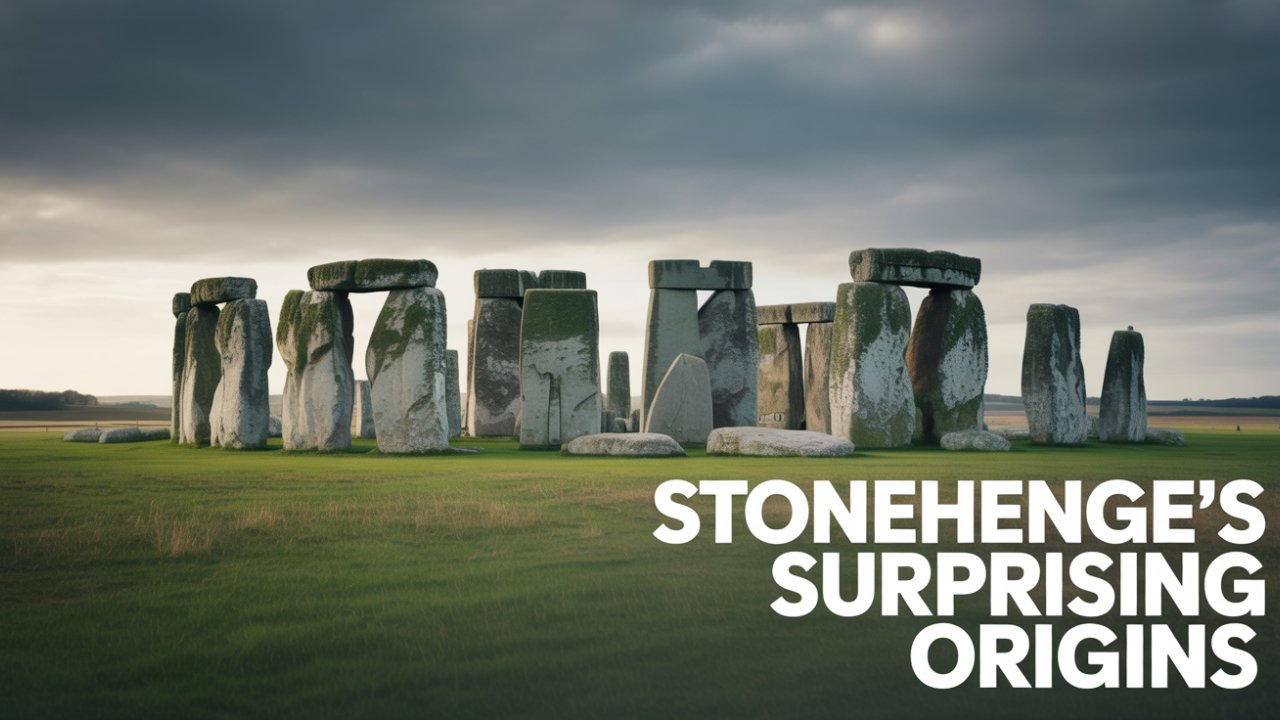On a windswept plain in England, a circle of giants stands watch. For millennia, these colossal stones have kept their secrets, sparking our curiosity and defying easy answers. Who on earth built this place? How did they pull off such an insane feat of engineering? And the biggest question of all: why? We’ve been told Stonehenge is one of history’s great unsolved mysteries, a puzzle from a lost people. But what if the stones themselves are the story? What if the clues are hiding in plain sight, scattered across the land and locked within the rocks?
Get this: For over 1,500 years, an ancient people—without the wheel—moved 40-ton stones hundreds of miles, then lined them up perfectly with the sun. We still don’t know exactly why. But what we have found is a series of mind-blowing clues that get us closer than ever to understanding Stonehenge’s real purpose. So forget the stories about wizards and aliens. The true story is way more incredible. Here are 20 rock-solid facts about how Stonehenge was built and the cosmic secrets it holds.
Fact 1: This Wasn’t a Weekend Project
Stonehenge wasn’t built in one go; it was an evolving monument constructed over an incredible 1,500 years. The work started around 3000 BC and continued in phases until about 1600 BC. To put that in perspective, imagine a single cathedral being built and rebuilt by over 60 generations of the same family. Each stage was a new chapter in the lives of the people who saw this place as sacred, a story told not with words, but with earth and stone.
Fact 2: It Started as a Graveyard
Long before the giant stones were hauled into place, Stonehenge was a place for the dead. The very first version, from about 5,000 years ago, was a huge circular ditch and bank called a henge. Inside this circle were 56 pits, now known as the Aubrey Holes. For about 500 years, these pits were used as a cremation cemetery. It seems that from its very beginning, Stonehenge was a domain of the ancestors. Archaeologists figure as many as 240 people were buried here, making it one of the biggest known Neolithic cemeteries in Britain.
Fact 3: It’s the Most Advanced Stone Circle in the World
There are over 900 stone circles in Britain, but Stonehenge is in a league of its own. It’s the planet’s only surviving prehistoric stone circle with lintels—those horizontal stones that sit on top of the uprights. This feature makes it the most architecturally sophisticated one ever built. The builders didn’t just plonk stones down; they created an interlocking structure, designed to last forever. This wasn’t just a circle; it was a masterpiece of prehistoric architecture.
Fact 4: It’s a Mix of Two Very Different Stones
The monument’s famous look comes from two types of stone. The massive outer circle and inner horseshoe are made of sarsens—towering sandstone blocks that weigh up to 40 tons each. The smaller stones, which form another circle and horseshoe inside, are called bluestones. These might seem small in comparison, but they still weigh between 2 and 5 tons each and hold a secret that is maybe the most shocking part of Stonehenge’s story.
Fact 5: The Stones are Insanely Well-Traveled
This is where the story gets wild. The giant sarsen stones were quarried from a place called West Woods, about 16 miles north of the site. A serious challenge, for sure. But the bluestones? They came from the Preseli Hills in Wales, a mind-boggling 180 miles away. Let that sink in. A prehistoric people, with no modern tech, somehow quarried and transported multi-ton stones across an entire country. No other Neolithic monument in Europe was built with stones from more than 10 miles away. So you have to ask, why on earth go to all that trouble?
Fact 6: Moving Them Was a Logistical Nightmare
There were no wheels in Britain at this time. So how did they do it? While we can’t know for sure, experts believe it was a masterclass in logistics and pure people power. The stones were probably loaded onto wooden sledges and dragged over land. Some theories suggest they used rollers or log tracks, like a primitive conveyor belt. It would have required an immense, coordinated community effort on a scale that’s almost impossible to imagine today.
Fact 7: They Were Shaped with Surgical Precision
The builders didn’t just drag rough rocks to the site; they shaped them with incredible care using only basic tools. They used large hammerstones made of sarsen and flint to chip away at the giant blocks, slowly sculpting them into rectangular forms. You can even see where they spent extra time smoothing the inward-facing surfaces of the stones—the ones that would be most visible. This wasn’t just building; it was artistry.
Fact 8: They Used Woodworking Tricks on Stone
This might be the most jaw-dropping detail of all. The builders used techniques you’d expect to find in carpentry, not stonemasonry. They carved protruding bumps, called tenons, on top of the upright sarsens, and then carved matching holes, called mortice holes, into the lintels so they would lock together perfectly. The lintels on the outer circle also fit together with tongue-and-groove joints. This made the circle incredibly strong and stable, proving they had a brilliant understanding of engineering.
Fact 9: Raising the Stones Was Sheer Genius
So, the stones are on site and perfectly shaped. Now what? How do you get a 40-ton pillar to stand up? Archaeologists think they dug a huge pit with one sloping side. The stone was slid into the pit, then slowly pulled upright using wooden A-frames, ropes made from plant fiber, and a whole lot of muscle. To get the 10-ton lintels on top, they might have built massive timber platforms or slowly levered them up, inch by inch, on a rising stack of logs.
Fact 10: The Lintel Circle is Perfectly Level
As if all that wasn’t enough, they added another layer of precision. The tops of the lintels forming the outer ring create a nearly perfect horizontal circle, hovering about 13 feet off the ground. This means the builders had to shape and finish the upright sarsens to a uniform height before they ever put the lintels on. To get that level of accuracy across a diameter of almost 100 feet without modern tools is just staggering.
Fact 11: They Did It All Without Metal or Wheels
It’s worth saying again: this entire wonder of the world was built with the simplest of tools. The builders used deer antlers as picks to dig the ditches and stone holes. They used stone hammers to shape the megaliths. And they moved them all without the wheel, which wouldn’t even arrive in Britain for another thousand years. Stonehenge is a monument to what people can achieve with grit, brains, and a shared goal.
Fact 12: The Builders Weren’t All Locals
So who were these incredible people? For a long time, everyone assumed they lived nearby. But modern science completely flipped that idea. Isotope analysis on the cremated remains from the Aubrey Holes revealed a stunning secret: many of the people buried there weren’t from the Stonehenge area. Their chemical signatures matched those of people from western Britain—specifically, from Wales, the exact same place the bluestones came from. It seems some of the people honored here traveled with the stones.
Fact 13: It’s the Center of a Sacred World
Stonehenge doesn’t stand alone. It’s the stunning centerpiece of a much larger sacred landscape that was used and developed for thousands of years. This area is dotted with hundreds of burial mounds, called barrows. It also includes other huge monuments like the Stonehenge Avenue, a ceremonial path, and the Cursus, a massive rectangular earthwork that’s even older than the stone circle. Nearby is Durrington Walls, Britain’s largest henge, where archaeologists believe the builders of Stonehenge lived and partied.
Fact 14: It’s Basically a Giant, Prehistoric Clock
So, why was it built? The most widely accepted theory is that Stonehenge was a sophisticated astronomical observatory, designed to track the movements of the sun. The whole monument is aligned on an axis that points directly to the sunrise on the summer solstice—the longest day of the year—and the sunset on the winter solstice, the shortest day. If you stand in the center on those days, the sun rises and sets in perfectly framed positions. This was no accident; it was the whole point of the design.
Fact 15: Sun-Watching Was an Old Tradition
While Stonehenge’s solar alignment is its most famous feature, it wasn’t a new idea. Archaeologists believe the builders were likely inspired by even older monuments in the area that also focused on the solstices. This suggests a long-standing tradition of sun worship or sky-watching in the region that reached its ultimate expression with Stonehenge. It was the grand finale of a cultural and religious tradition that had been building for centuries.
Fact 16: The Bluestones Might Have Been “Magic”
But what was so special about the bluestones? Why drag them 180 miles from Wales? One fascinating theory is that they were chosen for their special acoustic properties. When you strike these stones, they produce a loud, ringing sound, almost like a bell. This has led some to wonder if they were thought of as “healing” stones or had some other unique ritual power. The Preseli Hills were a place of myth, and bringing these “singing stones” to Salisbury Plain might have been an attempt to harness their magic.
Fact 17: It Was Party Central
Evidence from the nearby settlement at Durrington Walls points to another purpose: a place for massive parties. Excavations have uncovered enormous quantities of pig and cattle bones, suggesting that people traveled from all over Britain to take part in huge feasts. These gatherings probably happened around the winter and summer solstices, making Stonehenge not just an observatory, but the focal point for the biggest festivals of the year. It was a place where communities came together to celebrate.
Fact 18: It Was a Symbol of Unity
The fact that stones were brought from all over Britain has led to a powerful new theory. The sarsens were local, the bluestones came from Wales, and shockingly, new research shows the central Altar Stone may have come from a quarry in Scotland, over 400 miles away. Because of this, some believe Stonehenge may have been built as a monument to unification. At a time when different cultures were meeting, building a single monument with stones from various ancestral homelands could have been a powerful political and religious statement—a way to bring the peoples of Britain together.
Fact 19: Its Purpose Kept Changing
The 1,500-year history of Stonehenge also shows that its meaning wasn’t set in stone. It started as a cemetery for a select group of people. Then, it was transformed into a massive stone circle for watching the stars and holding huge festivals. Later still, after new groups arrived from Europe, it seems to have become a burial ground for a new elite. The monument wasn’t static; it was adapted and re-imagined by each new generation, reflecting the changing beliefs and politics of the time.
Fact 20: It’s a World Treasure
Today, Stonehenge, along with the surrounding landscape and the nearby site of Avebury, is recognized as a UNESCO World Heritage Site. This title acknowledges it as a landscape without parallel, a monument to the creative genius, engineering brilliance, and spiritual dedication of a prehistoric people. It remains a powerful symbol of human ingenuity and our timeless quest to understand our place in the cosmos.
The story of Stonehenge is always changing as we learn more. So what do you think its main purpose was? A temple to the sun? A calendar carved in stone? Or a grand symbol of unity? Let us know what you think in the comments. And if you want to keep exploring the greatest mysteries of the ancient world, make sure to subscribe and ring that notification bell so you don’t miss our next adventure.
Conclusion
From a simple circle of graves to the most advanced stone circle in the world, Stonehenge is so much more than a pile of rocks. It’s a story of incredible effort, brilliant thinking, and profound belief. It was a place where the worlds of the living and the dead collided, where communities from across the island gathered, and where the heavens literally touched the Earth. Plenty of questions are still unanswered, but the facts we do have reveal a truth far more amazing than any legend. The people who built Stonehenge didn’t leave us any books, but they left us something far more powerful: a monument that continues to challenge us, inspire us, and connect us to our most ancient ancestors.





